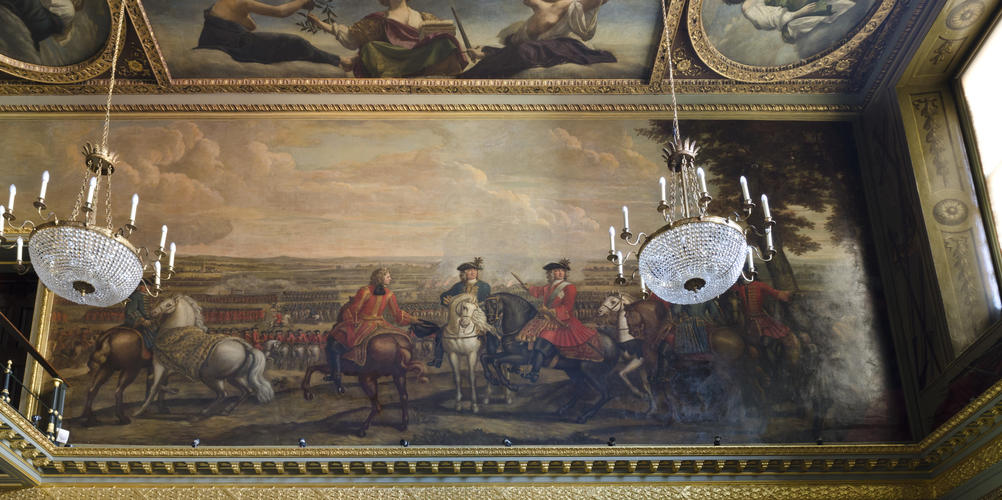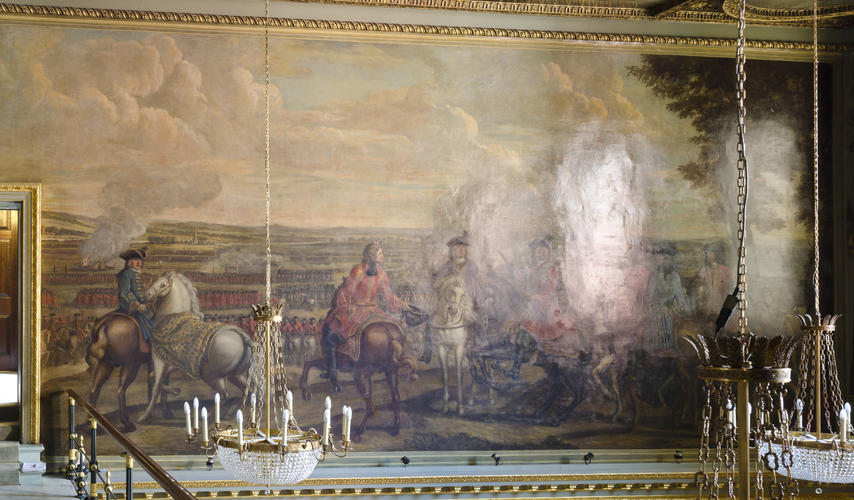-
1 of 253523 objects
The Battle of Blenheim, 13 August 1704: John Churchill, 1st Duke of Marlborough (1650-1722) and his Staff Surveying the Attack of John Cutts (1661-1707) on the Village of Blenheim c.1713-14
Oil on plaster | 437 x 1070 cm (image) | RCIN 408442

Louis Laguerre (1663-1721) and assistants
The Battle of Blenheim, 13 August 1704: John Churchill, 1st Duke of Marlborough (1650-1722) and his Staff Surveying the Attack of John Cutts (1661-1707) on the Village of Blenheim c.1713-14


-
In 1713 Louis Laguerre was commissioned to decorate the walls of the main hall and the two flanking staircases of Marlborough House, the London residence of the Duke and Duchess of Marlborough. The subject was to be the significant battles of the Spanish Wars of Succession (1701-14); led by the Duke of Marlborough, Britain and the Allies saw victories at Blenheim (1704), Ramillies (1706), Oudenard (1708) and, less decisively, Malplaquet (1709). The murals were to be 'the only signs of bravura or ornamentation in a house that was otherwise very plain and simple' (John Charlton, Marlborough House, 1978). Laguerre was paid £500 for them. The murals have had a chequered conservation history and parts have been almost entirely repainted.
The main central hall (Blenheim Saloon) is decorated with the events of the Battle of Blenheim, 1704 (RCINs 408442, 408443, 408445). The window wall is painted with panels showing military equipment (RCIN 408444).In 1700, when the death of Charles II of Spain threatened to plunge Europe into war, William III put John Churchill, later 1st Duke of Marlborough (1650-1722), then a relatively inexperienced and untried military leader, at the helm of British expeditionary forces, as part of the 'Grand Alliance' formed against France. The Spanish Wars of Succession (1701-1714) followed, which saw the 'Grande Alliance' of England, Austria, the Dutch Republic, the Holy Roman Empire, Piedmont-Savoy, Prussia, Portugal and Hapsburg Spain pitched into war against France, and France's supporters from amongst the monarchist regions of Spain that had automatically accepted duc'Anjou as Philip V.
Here, the Duke of Marlborough, in a red coat and with the blue riband of the Order of the Garter, gestures out towards the rows of troops lined up on the battlefield below before the villages of Blenheim (at left) with Sonderheim, Unterglau and Lutzingen in the background – the French line of defence. Smoke rising from the battlefield below heralds the attack of John Cutts on the village of Blenheim.
The figure in blue to the left of Marlborough may be William Cadogan, 1st Earl Cadogan (1675-1726); and to his left, possibly John Cutts (1661-1707). It is likely that the figure group to the right includes Lord George Hamilton, Earl of Orkney (1666-1737), one of Marlborough's most trusted generals and possibly Charles Churchill (1656-1714), Marlborough's younger brother.
This scene, like the equivalent tapestry at Blenheim, suggests Marlborough's role as commander-in-chief and tactician rather than seeking to be a faithful representation of the scene. He appears here serenely atop his horse, directing his staff to survey the battle, while the viewer shares his comprehensive, aerial view of the proceedings. Practically, the scene appears to depict the period of the battle when Marlborough and his staff were awaiting Prince Eugene's signal to move off; the Duke has not yet mounted the white charger he rides everywhere else he appears in the series – it appears, held by an officer, at the far left. However, the decision to show Cutts' attack just beginning allows Laguerre to emphasise what contemporaries commonly considered the most brilliant aspect of the Duke's approach, the two-pronged, concentrated attack on the enemy, led respectively by Cutts and Prince Eugene, which encouraged the French to send reinforcements too precipitously, and thus to trap themselves inside Blenheim. This scene's placement directly opposite the illustration of Eugene's attack thereby underlines the simultaneous nature of the attack; moreover, although the other members of the Duke's staff are closely grouped around him, Marlborough is the only figure in the scene who faces directly southwards, and therefore spatially towards the dominating scene of French surrender. While his close relationship with the other members of the Grand Alliance, and with the British generals, is thus emphasised, Laguerre makes it clear that the victory is the result of his patron's clear-sighted strategic talent.
An oil sketch on canvas, 72 x 138 inches, formerly (until about 1724) in Marlborough House, now at Grimsthorpe Castle; small oil copy, 77.5 x 142 cm, at Plas Newydd; small oil copy 29 ½ x 56 inches, last recorded at Adare Manor. Copper plate engraving by Du Bosc and Du Grenier (published by Carington Bowles, 1717); see RCINs 751212, 750315, 750313 and 820865.b.
Provenance
Commissioned in 1713 by the 1st Duke and Duchess of Marlborough
-
Creator(s)
-
Medium and techniques
Oil on plaster
Measurements
437 x 1070 cm (image)
Category
Object type(s)